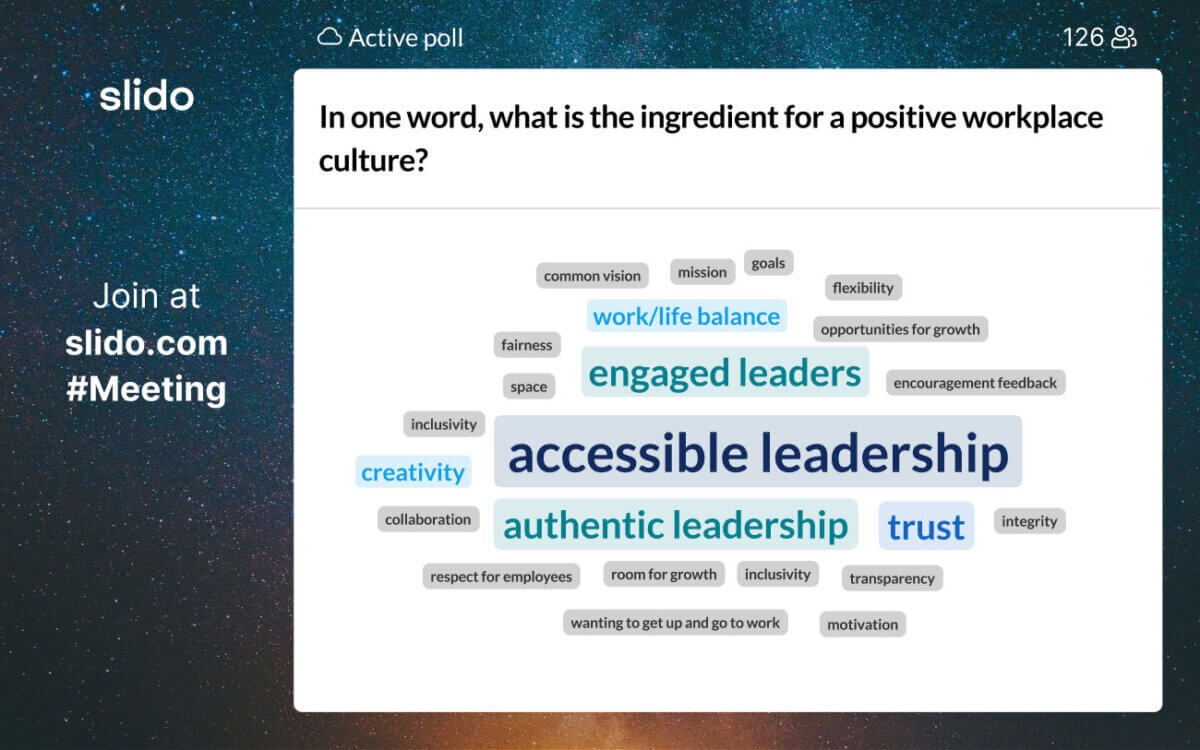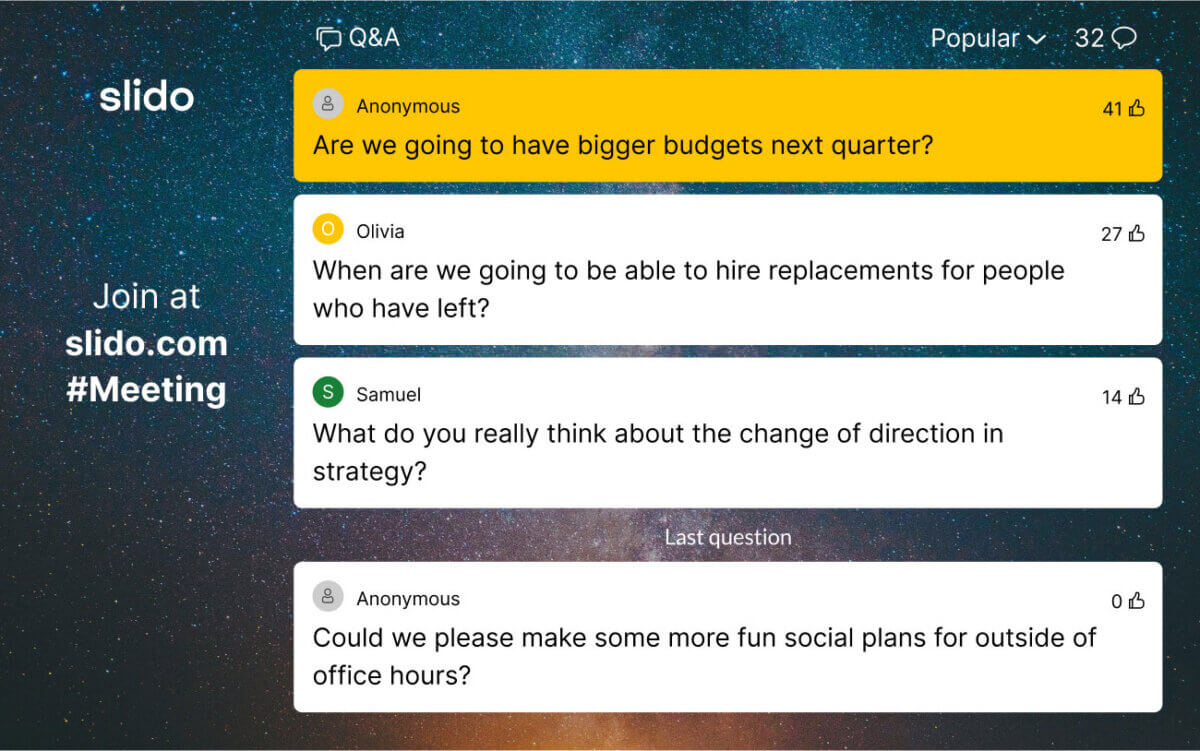As a leader, what do you think of when you hear the words ‘Q&A session’? Perhaps these words make you a little nervous.
You may feel exposed to the possibility of tough questions during a live leadership Q&A with your employees, and feedback that’s not always guaranteed to be positive.
But there’s a good reason to be brave and add a Q&A or an AMA (Ask Me Anything) session to your high-stakes meetings. If you want to foster trust and transparency in your workplace, Q&As can help accelerate this, as our latest research has shown.
In this article, we’ll explore some of the findings this study has brought on Q&As and discover how they can become powerful tools in your arsenal for building trust within your team.
- With Q&A comes higher risk – but higher reward
- Why leaders are using Q&As to build a better company culture
- Why should leaders be open to real-time feedback from employees?
With Q&A comes higher risk – but higher reward
Many leaders are used to the ‘safer’ nature of sending out surveys to check in with employees. Surveys certainly have their place as a way to collect that all-important feedback.
- They offer a way to gauge and quantify employee engagement and satisfaction over time
- They enable you to take a regular pulse check of what your employees think, how they feel, and what they need.
- They help you understand the overall mood in your company and detect any issues, trends, or behavior patterns
However, surveys rarely offer a two-way conversation between leaders and employees. By combining surveys with live Q&A sessions, you’ll create an avenue for a mutual dialogue where employees can truly feel that they have a voice – which is vital for creating trust and a more positive company culture.
As Maximilien A. Notter, Co-CEO at HUMANOO told us: “There’s no more powerful example in my view than a leader who walks the talk, who puts himself at risk, by standing vulnerable in front of people, getting ready to answer the toughest questions.”
We wanted to learn more about how leaders are approaching building trust and transparency within their teams, including in their Q&A sessions, so we spoke with 18 senior leaders for an in-depth qualitative research study, Building and Maintaining a Healthy Workplace Culture.
Why leaders are using Q&As to build a better company culture
The 18 senior leaders (or ‘leaders of leaders’) are all based in the US, working at companies with over 1,000 employees, and have 15 or more direct reports*.
When we asked them what the ingredients for a positive workplace culture were, they agreed that an accessible, engaged and authentic leadership was at the top of the agenda.

Most of the leaders are using live Q&A sessions as a way to connect directly with employees, alongside the usual surveys that are sent out and then analyzed privately.
As one leader says: ‘We [also] use Q&A… during all-hands, so people have an opportunity to ask questions. I think it’s a good way to engage and help make [participants] stakeholders along the way of whatever you’re trying to accomplish.’
The leaders agree that another key element for trust-building and better company culture is inclusivity and running more inclusive meetings.
In 2023’s hybrid working world, it’s never been more important to hear from employees, whether they’re in the office, working remotely, or a mixture of both.
Q&As are built with inclusivity in mind, allowing staff to ask the questions that are most important to them from wherever they’re working, whatever their setup.
Let people ask questions asynchronously in advance of the Q&A, enabling them to contribute to the discussion no matter what their time zone.
Watch our latest webinar on leadership Q&A here:
Why should leaders be open to real-time feedback from employees?
There’s no denying that a live Q&A session carries more risk than a ‘static’ survey.
While surveys are sent out and analyzed privately, a Q&A will give instant feedback publicly and in real time.
The live nature of a Q&A means that leaders will have to address awkward questions head-on – but the benefit of doing this is an increased sense of authenticity within your team.
You may have gone one step further and enabled anonymity in surveys, so your employees can really be candid about their feelings on your company and its culture.
But it’s important to highlight the difference between the type of ‘fixed’ comments that come from surveys, however, and the valuable real-time feedback that a Q&A session will allow.
During a Q&A session, features like the upvoting option will also mean employees have the power to show you which questions are the most burning issues to be addressed.
As one leader says, “It can be powerful for a quiet person, or anyone, to see that their comment or question is popular amongst the group when they receive upvotes from their colleagues.”

Another leader tells us, “It’s interesting to not just collect what people are thinking, but also to get a popular vote. You know while you’re doing [a Q&A] if something is really resonating [and getting the most] votes.”
By giving an answer to the most pressing – and often toughest – issues during a live Q&A, you’ll show that as a leader you care about the issues people have.
As one respondent told us, “If there’s something negative [in a Q&A], then [leaders often] don’t want to address it. They only want to address the positives. But if you’re able to address everything that’s coming up, I think that definitely helps [in terms of] leadership capacity and workplace culture.”
In fact, Slido’s June 2023 Brand Tracker study** shows that when leaders ask employees for feedback on job satisfaction and company changes via a Q&A, they’re actually perceived as more approachable and caring than if they asked for the same feedback via a survey.
Research also shows that using a Q&A sends a stronger signal to employees that leaders are willing to act on feedback than if they are using surveys.
Overall, the statistics reveal using Q&As in this manner helps to show that leaders are approachable and that they care. If it’s your mission to build trust and rapport with your employees, they’re worth considering.
How leaders should deal with tricky questions during Q&A sessions
There’s the chance of difficult questions coming up, but there are ways to handle these.
It might feel even riskier to enable anonymity during a Q&A session, but by trusting your employees to do so, they’ll feel they have a safe space to ask the questions that really matter to them openly.
This will level the playing field for any employee to have their say, no matter if they’re shy, what country they live in, or what their job role is.
In the long term, this will help you build a greater sense of transparency and inclusion within your organization.
There’s also the option to moderate questions so that you can do some quality control (and keep the meeting on track). But bear in mind that censoring questions heavily will impact the power of your Q&A session and its potential for building trust with employees.
And for leaders who feel nervous about running a Q&A, remember that the more you do them, the better you’ll get at running them.
While you might not want to appear nervous in front of your audience, showing some vulnerability will in turn reassure employees that you’re a real human being, too, which will help with showing authenticity within your leadership. As one leader tells us: “Trust comes from a human not a polling tool.”
It might feel scary at first, but it’s a way to open doors with employees that will foster open communication and engagement long-term within your organization.
Read more: 4 Reasons to Run an Anonymous Q&A Session (+1 Reason Not To)
Over to you…
Leaders in our qualitative study agree that Q&As engage employees, and help to build a stronger company culture in the long term.
It takes some courage to start running Q&A sessions, which is why we want to be here to support you in your journey.
By giving your employees a voice, you’ll be able to build a better company culture and engage with your employees in a transparent manner.
Slido is here to help. Just reach out to us below, and we can get you started.
*The study was commissioned by Slido but conducted by an independent market research company. The leaders involved manage 15 or more staff members within at least two levels of reporting; the staff members who directly report to the participants also have staff members reporting to them. Three respondents in the study managed fewer than 15 reports.
**Brand Tracker survey also commissioned by Slido but conducted by an independent market research company.




